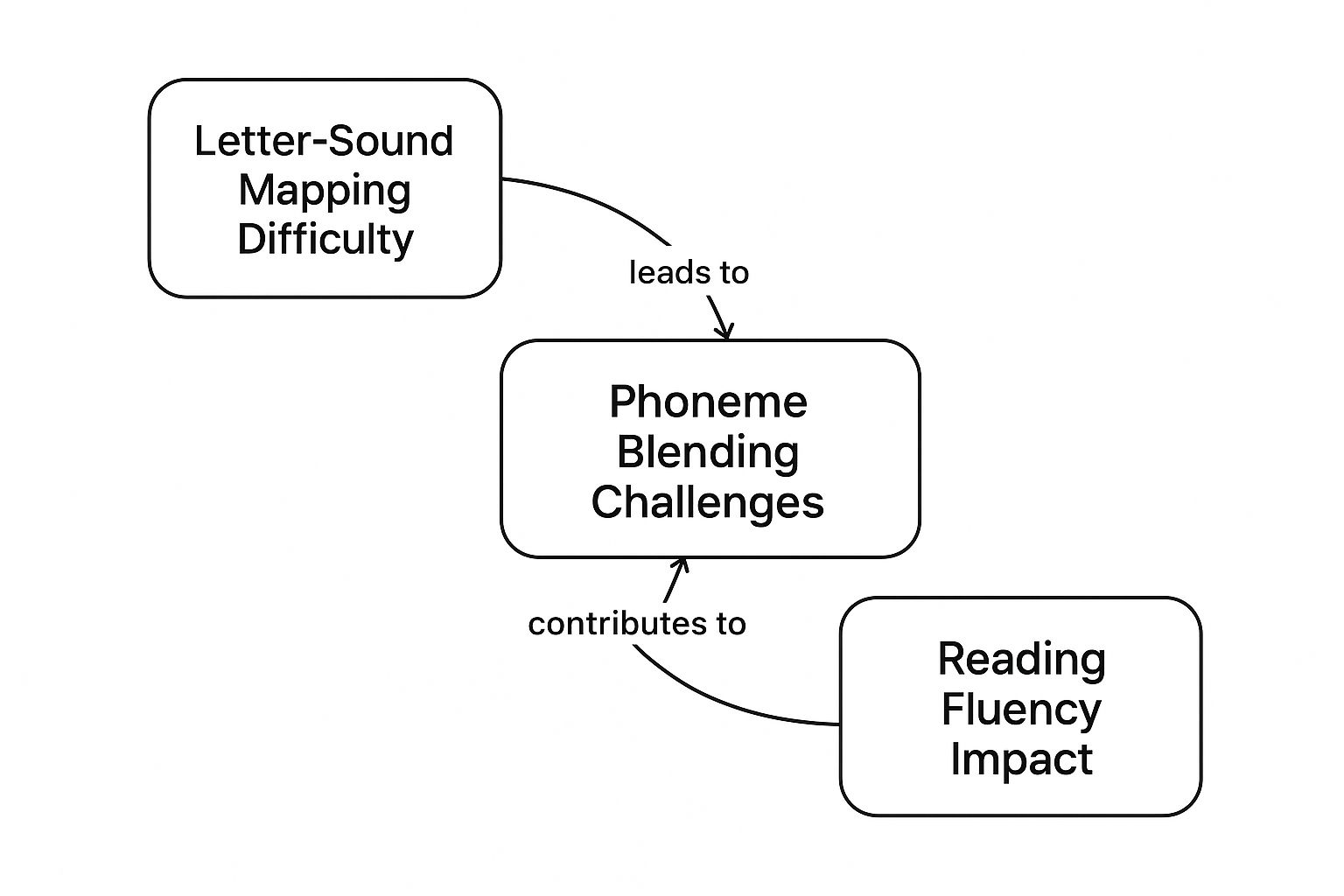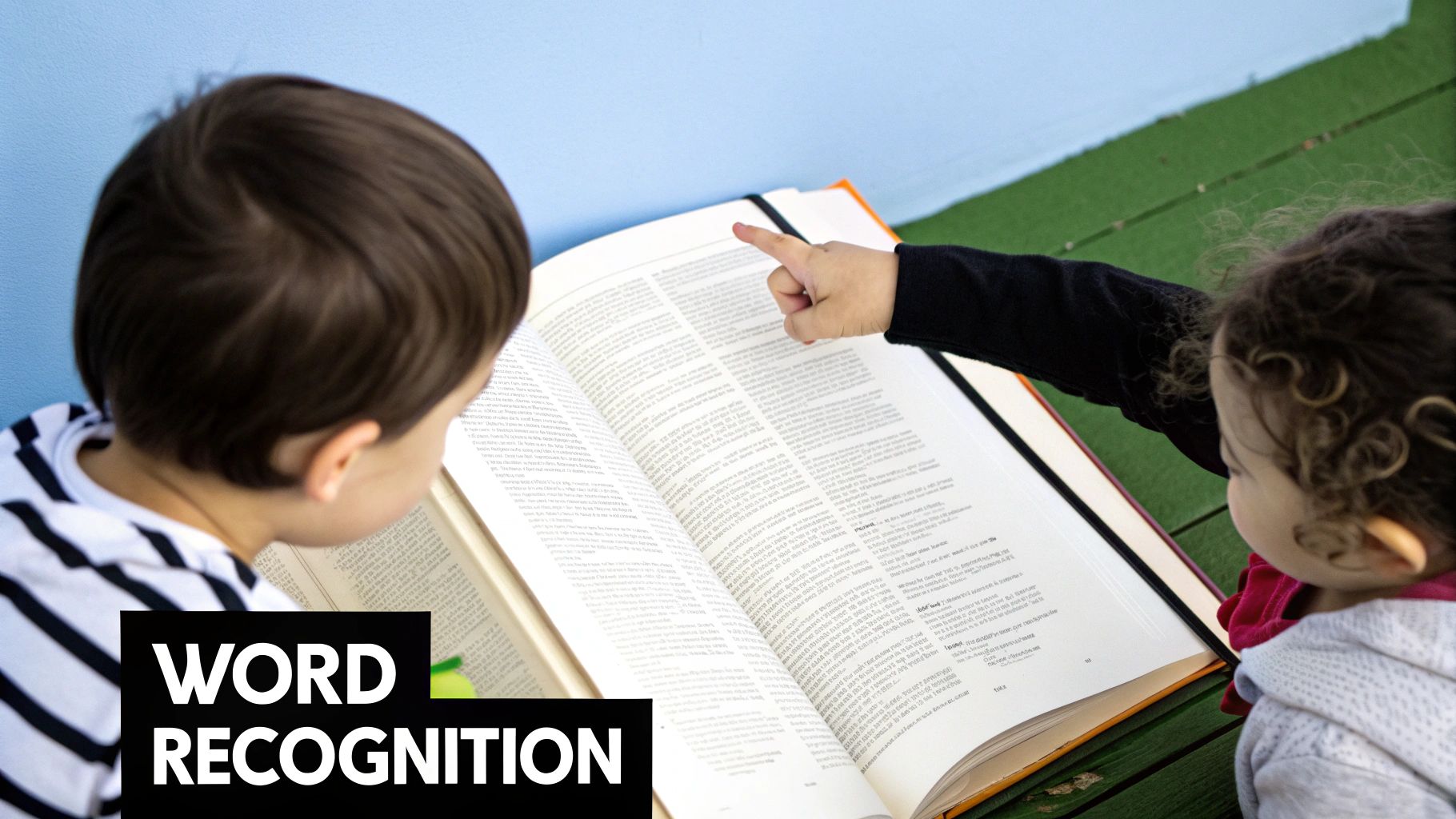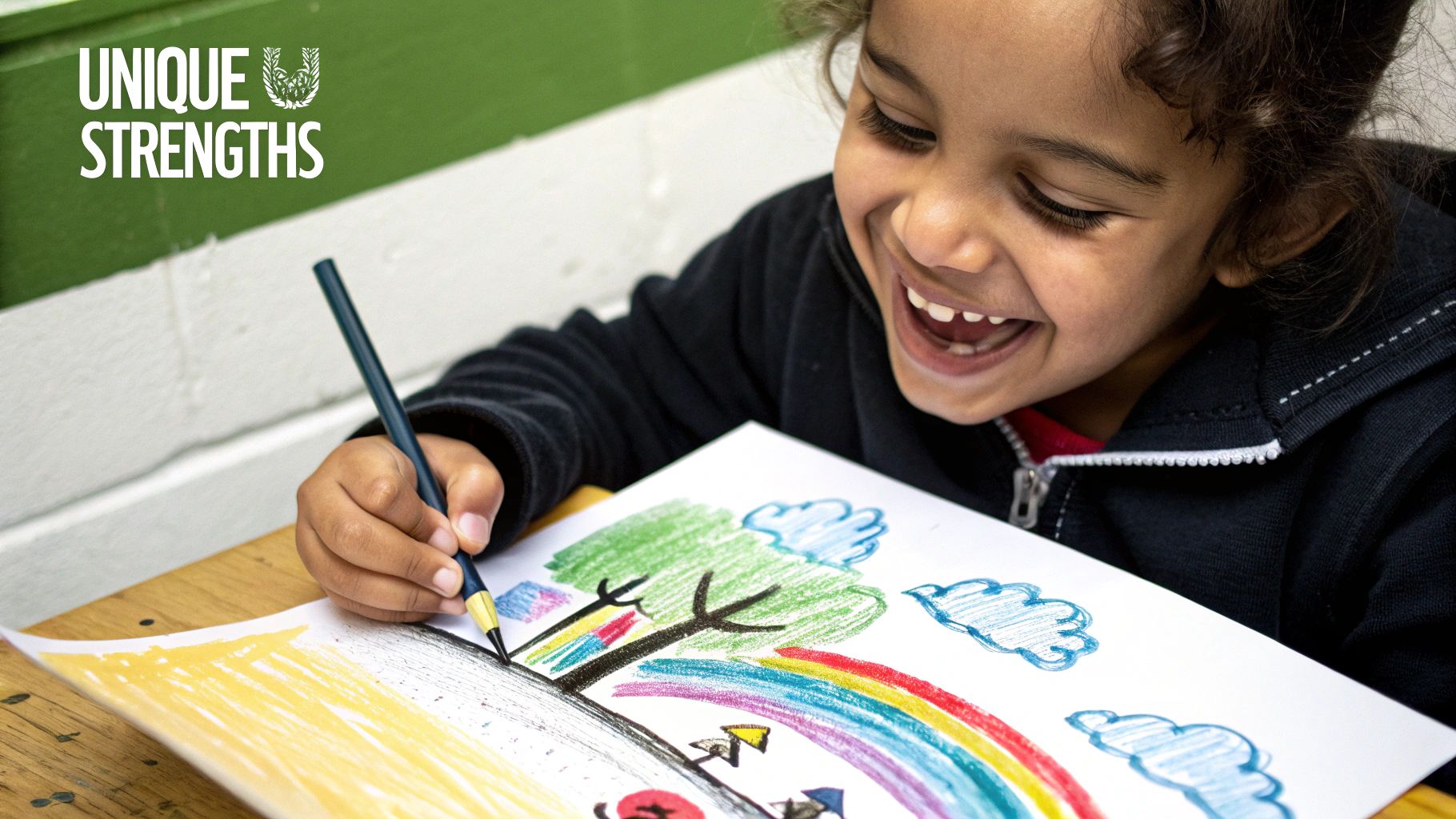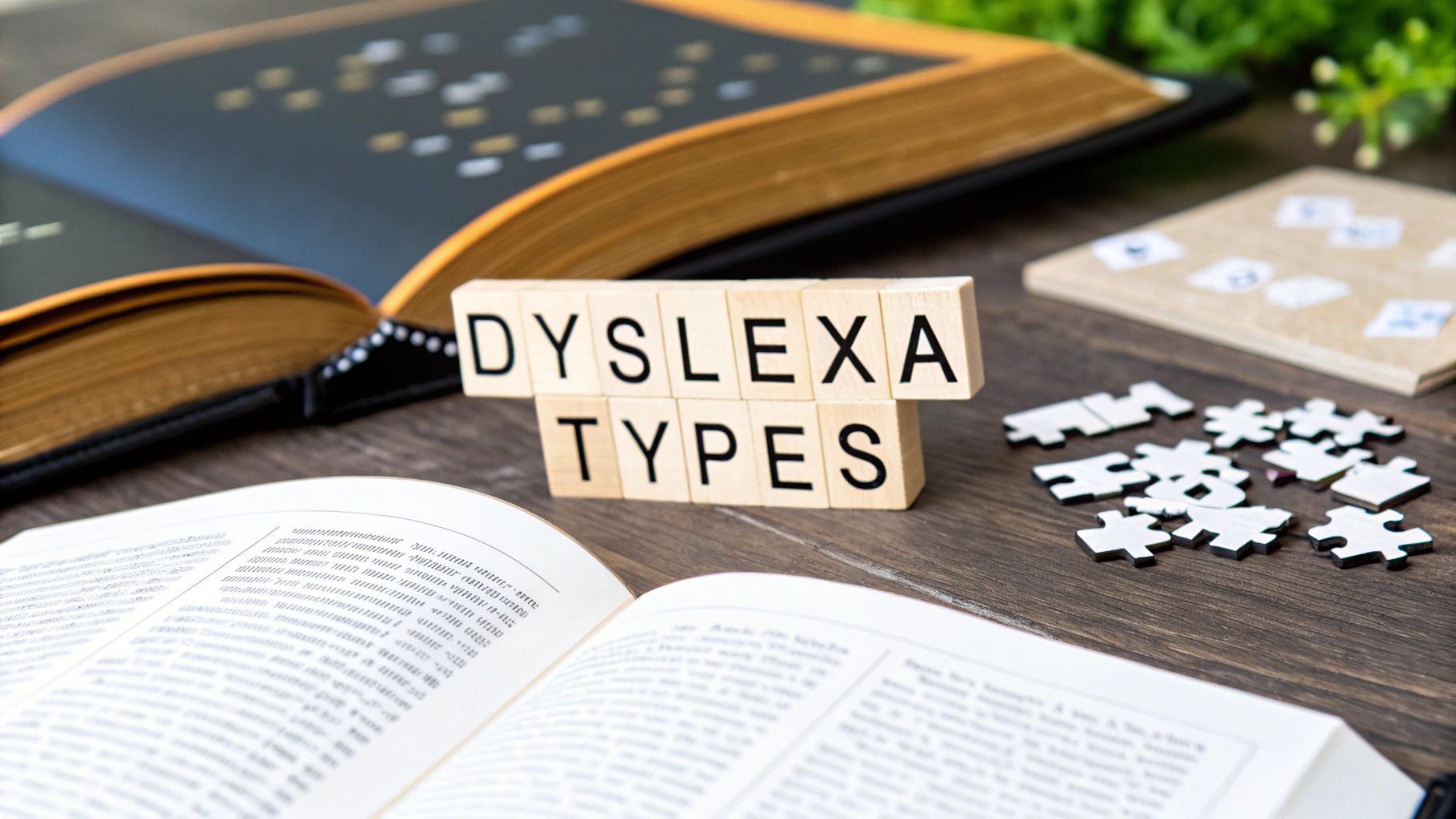Getting a diagnosis can feel overwhelming, but the first real step towards helping your child is understanding what different types of dyslexia actually are. It's a journey that starts not with a label, but with love and a desire to see the world through their eyes. Dyslexia isn't one single, clear-cut condition. Instead, think of it as a spectrum of learning differences, each showing up in different ways—from the heartache of struggling with the sounds in words to the sheer confusion of not recognising a word they’ve seen a hundred times before.
Moving Beyond a Single Label

When most people hear the word "dyslexia," the first thing that often comes to mind is a child mixing up letters like 'b' and 'd'. While that can certainly be a symptom, it’s only a tiny piece of a much larger and more complex puzzle.
Believing dyslexia is just one thing is like saying all music is just one song—it completely misses the rich and varied experiences of those who live with it.
At its core, dyslexia is about how the brain processes language. For your child, that's not some abstract definition; it's the daily frustration during homework, the anxiety that bubbles up when asked to read aloud in class, or the sheer confusion when words on the page just refuse to stick. Imagine your bright, curious child feeling like they are constantly letting you down, despite trying their absolute hardest. Your journey as a parent starts here: by shifting your perspective away from a restrictive label and towards a deeper understanding of your child's unique way of thinking.
The Emotional Experience of Dyslexia
Before we dive into the specific types, it’s so important to pause and consider what this feels like for a child. Imagine you’re trying to solve a puzzle, but every time you look away, the pieces change shape. That’s the kind of daily reality many children with dyslexia face, and it's no wonder it can lead to feelings of inadequacy, anxiety, and low self-esteem. They see their friends reading chapter books while they are still struggling with the first page, and that feeling can be crushing.
Understanding the why behind your child's struggles is the most powerful tool you have. It transforms frustration into empathy and allows you to become their most effective advocate, celebrating their effort and resilience above all else. It's about seeing the brave child behind the struggle.
Why Knowing the Types Matters
Pinpointing the specific nature of your child’s dyslexia isn’t about forcing them into a neat little box. Far from it. It’s about creating a clear roadmap for support that meets them exactly where they are. When you know what you’re dealing with, you, their teachers, and any specialists can choose the right tools and strategies that actually align with how their brain works. A practical example: if your child struggles with phonological dyslexia, endless sight word drills will only increase their frustration. But fun, sound-based games could be the key that unlocks everything. This targeted approach can make a world of difference to their confidence and progress.
For countless families across the United Kingdom, this is a shared journey. It's estimated that dyslexia affects around 10% of the UK population, with about 4% facing more severe challenges. That means millions of children and adults are navigating these hurdles every day.
This isn’t some rare condition; it’s a common variation in how our brains are wired. You can learn more about the prevalence of dyslexia from recent UK studies. The key thing to remember is that your family is not alone.
Phonological Dyslexia and the Challenge with Sounds
When people think of dyslexia, this is usually the type that comes to mind, even if they don't know the official name. Phonological dyslexia is the most common form, and it all comes down to a fundamental snag in connecting the letters on a page to the individual sounds they're supposed to make.
Imagine trying to build a complex LEGO model, but the instructions are blurry, making it impossible to see which piece connects where. A child with phonological dyslexia feels a similar kind of deep-seated frustration. They see the letters, but their brain struggles to translate those symbols into the right sounds needed to form a word. Think of a child trying to read 'ship' but their brain can't easily distinguish the 'sh' sound from the 's' sound, so they might say 'sip' instead, getting confused and upset.
This has nothing to do with intelligence or how hard they're trying. It's simply a neurological difference in how the brain processes the most basic building blocks of language—the sounds, or phonemes. For most of us, hearing that 'cat' and 'hat' rhyme, or knowing that 'sun' is made of three distinct sounds (s-u-n), is second nature. For a child with phonological challenges, these connections are anything but obvious.
What Does This Look Like in Daily Life?
The struggle with phonological processing can show up in ways that might seem confusing. Your child might have a fantastic vocabulary and be a brilliant storyteller, but then completely freeze when faced with a new word in a book. It’s heartbreaking to watch them stumble over words you know they understand when spoken.
You might notice challenges like:
- Difficulty Sounding Out New Words: A word like 'adventure' can feel like an insurmountable wall. They struggle to break it down into smaller, manageable sound chunks ('ad-ven-ture').
- Trouble with Rhyming: Games involving rhyming words can spark anxiety instead of fun. They might not be able to hear the sonic similarity between 'bee' and 'tree', looking at you with a blank, worried expression.
- Spelling That Doesn't Match Sounds: Their spelling might be phonetic but incorrect. Think 'fone' for 'phone' because they can't recall the specific letter pattern ('ph') for that sound.
- Segmenting and Blending Issues: Breaking a word like 'caterpillar' into its syllables (ca-ter-pil-lar) can feel impossible. In the same way, blending the sounds /b/ /a/ /t/ back into the word 'bat' is a huge hurdle.
This infographic clearly shows how these initial challenges with letter-sound mapping can spiral into broader reading difficulties.

As you can see, the core issue of linking letters to sounds has a direct knock-on effect. It hampers a child's ability to blend those sounds into words, which in turn slows down their reading fluency and makes the whole process feel exhausting.
The Emotional Impact of the Sound Struggle
When a child consistently struggles with a skill their friends seem to pick up effortlessly, it takes a serious emotional toll. They see others reading with ease and can quickly start to believe they are "not smart enough." This feeling of falling behind often creates a cycle of avoidance, where reading becomes a source of dread rather than discovery. Suddenly, their favourite bedtime story becomes a source of anxiety.
Your child's reluctance to read isn't defiance; it's often a form of self-protection. Recognising the exhaustion and self-doubt they feel is the first step in providing the gentle, patient support they need to rebuild their confidence. They need your hug as much as your help.
Supporting them means shifting the focus from performance to play. It's about creating positive, low-pressure experiences with sounds and letters that feel more like a fun game than a test. The goal is to rebuild their relationship with words from the ground up. These foundational skills are crucial, and you can explore more ways to support them in our guide on how to improve reading comprehension.
Practical Ways to Build Phonological Awareness
Helping your child at home doesn't require specialist training—just a bit of patience and a playful spirit. The key is to weave sound-based learning into everyday activities, making it enjoyable and connecting with them in the process.
Here are a few simple, game-based ideas to try:
- "I Spy" with Sounds: Instead of colours, play "I spy with my little eye, something beginning with the sound /p/." This helps your child isolate and identify the first sound in words in a fun, no-pressure setting, like during a walk in the park.
- Rhyme Time: Make up silly rhymes together while you're driving or doing chores. "Can you think of a word that sounds like 'car'?" It doesn't matter if the words are nonsense; the goal is to practice hearing similar sound patterns and share a giggle.
- Clapping Syllables: Say a family member's name and clap out the syllables together. "Let's clap for Ma-ri-a!" This helps them feel the 'beats' in words, making language physical and fun.
For children with phonological dyslexia, connecting sounds back to letters is a huge part of the puzzle. Resources like engaging alphabet flash cards can be a fantastic tool for practising this letter-sound correspondence. By turning these exercises into fun, shared moments, you help your child build crucial skills without the pressure of getting it 'right'.
Surface Dyslexia: When Familiar Words Look Strange
Have you ever noticed your child sounding out a word perfectly one minute, only to stare blankly at the exact same word a few pages later? This is a classic hallmark of surface dyslexia. It’s a type of dyslexia where the brain struggles to recognise whole words by sight, even when phonics skills are strong. It can be heartbreaking to watch their confidence crumble over a word they just read moments ago.
For these children, reading isn't about recalling familiar word shapes; it’s about decoding every single time. Every encounter with an irregular word—like "enough," "yacht," or "colonel"—can feel like the very first time.

Imagine them sounding out "yacht" phonetically—it might come out as "y-atch-t." They have the sounding-out skill, but their brain doesn't connect that jumble of sounds to the smooth, instant recognition of the word "yacht." This constant mismatch is baffling for the child and often just as confusing for parents. It explains why they might fly through a phonetically simple book but grind to a halt on a page with common, tricky words.
This struggle means they often reread lines without getting any faster or more confident. It's an exhausting, confidence-draining process.
Signs of Surface Dyslexia in Daily Reading
So, what should you look out for? It's less about a single error and more about a persistent pattern that can cause real distress during reading time.
Keep an eye out for these tell-tale signs:
- No word memory: They sound out the same common words like 'what' or 'said' over and over, as if they've never seen them before, often looking at you with pleading eyes.
- Over-reliance on phonics: They use slow, letter-by-letter decoding for everything, even high-frequency words like "the" or "was."
- Guessing or skipping: When faced with an irregular word, they'll often guess based on the first letter or just skip it entirely to avoid the feeling of failure.
- Inconsistent recognition: A word they knew yesterday seems completely foreign today. This isn't carelessness; it's a genuine processing hiccup.
Spotting these behaviours early is crucial. It’s the first step to shifting your support from generic reading practice to targeted strategies that actually address the root of the problem, helping prevent long-term frustration.
How Surface Dyslexia Feels for a Child
For a child with surface dyslexia, reading is an intense mental workout. They might adore stories and beg to be read to, but the act of reading themselves feels unpredictable and overwhelming. Each page is a minefield of words that might suddenly look unfamiliar.
This constant effort can easily lead to tears, avoidance, or an outright refusal to pick up a book. It’s not that they don't want to read; it's that the process is emotionally exhausting.
"It's like my brain erases the words as soon as I look away," a nine-year-old once told me. That perfectly captures the feeling of words just not "sticking." Imagine how defeating that must feel night after night.
Comparing Phonological and Surface Dyslexia
To choose the right support, it's vital to understand the difference between the main types of dyslexia. While both cause reading difficulties, their origins are completely different.
Here’s a quick-glance table to help clarify things.
| Challenge Area | Phonological Dyslexia (Sound-Based) | Surface Dyslexia (Sight-Based) |
|---|---|---|
| Core Difficulty | Trouble matching letters to their individual sounds. | Struggles to store and instantly retrieve whole-word forms. |
| Problem Words | New or complex words that require sounding out (e.g., "adventure"). | Irregular, non-phonetic words (e.g., "colonel," "through"). |
| Reading Speed | Slow because blending sounds together is difficult. | Slow because every word needs to be decoded from scratch. |
| Spelling Errors | Phonetically plausible mistakes (e.g., writing "fone" for "phone"). | Inconsistent, visually-based errors (e.g., "enuff" for "enough"). |
Understanding this distinction is key—it helps you move away from frustrating phonics drills (which won't help here) and towards visual strategies that will.
Strategies to Build a Strong Sight Vocabulary
The goal is to help your child build a mental "photo album" of words. This requires repeated exposure combined with engaging, multi-sensory techniques that play to their strengths and make learning feel like a success.
Start small. Focus on a manageable list of high-frequency irregular words—the ones they'll see most often.
- Create Visual Anchors: Make sturdy flashcards with one word per card. Add a simple picture and maybe a silly mnemonic hint to help the word's shape stick in their long-term memory. For the word 'said', you could draw two little speech bubbles.
- Make it a Game: Don't just drill. Play memory match, snap, or bingo with the cards. The goal is fun, low-pressure repetition that feels like quality time together, not a test.
- Use Tech: Create a personal digital book where your child can record themselves saying each word. Tapping the word to hear it read aloud in their own voice reinforces the sound-sight connection.
The trick is to rotate and review words weekly, but always let your child lead. When they feel in control, they stay engaged.
Measuring Progress with High-Frequency Words
Tracking progress isn't about creating pressure; it's about celebrating wins. For a child who feels like they're getting nowhere, seeing tangible proof of their hard work can be a huge motivator.
- Keep a visible chart: List the words they've mastered. Add a sticker or a tick next to it each time they recognise it instantly. This visual proof of success can be incredibly powerful for their self-esteem.
- Use brief, timed checks: See how many words from their list they can read in 30 seconds. Watching that number go up over time is incredibly empowering.
- Celebrate milestones: Mastered 10 new words? That calls for a small reward or a big high-five. This builds positive associations with reading.
Using Technology and Games
Modern tools can be a fantastic ally. Many apps are designed to make sight word practice feel less like work and more like play.
- Look for interactive reading apps that highlight tricky words in stories.
- Find memory games that track progress and offer instant, encouraging feedback.
- Try word-creation games that get them building and recognising sight words in different contexts.
- Use reading log apps that award badges or points for mastering new words.
These tools blend focused practice with the fun of gameplay, helping reinforce word recognition without the battle.
Don't Forget Emotional Support and Encouragement
Surface dyslexia is deeply frustrating. Imagine the fatigue of having to re-learn words you know you've seen before. Your empathy and consistent praise are the foundation of their success. They need to feel that you are on their team, no matter what.
Frame their progress in a positive light. It’s not about what they can’t do; it’s about what they’re learning to do.
Remind them: “Every tricky word you master is proof that you’re building a stronger reading brain. It’s a victory, not a failure.” Your belief in them can change everything.
Reinforce every win, no matter how small. By connecting reading to topics they genuinely love, you help reclaim it as a positive, rewarding experience.
Your Next Steps
Ready to get started? Don't try to do everything at once. Pick just one strategy from the list above and try it this week. Track those small wins and celebrate them together. Building your child's confidence is just as important as building their sight vocabulary.
Understanding Other Related Learning Differences
Dyslexia rarely travels alone. For many children, their reading challenges are part of a broader, more intricate picture of how their brain processes information. Getting to grips with these related differences isn't about collecting more labels; it's about seeing your child's complete profile with clarity and compassion.
It helps explain why certain strategies work wonders while others fall flat. By broadening our view beyond just the different types of dyslexia, we can tailor support that truly meets your child's holistic needs, reducing frustration for everyone involved.
When Naming Speed Becomes a Hurdle
Have you ever watched your child confidently recite the alphabet, only to freeze when you point to a letter on a flashcard and ask, "What's this?" That puzzling moment might not be about knowledge at all, but about speed. It's a disconnect that can leave both of you feeling bewildered.
This is often a sign of a Rapid Automatised Naming (RAN) deficit. It’s the struggle to quickly and automatically name familiar things like letters, numbers, colours, or objects. The information is definitely in their brain, but accessing and retrieving it on demand is a major challenge.
It’s like knowing all the players on your favourite football team but stumbling to name them as they run onto the pitch. For a practical example, a child might be able to say the numbers 1 to 10 perfectly, but when shown the number '7' on a card, there's a painful pause as their brain searches for the name. This processing lag directly impacts reading fluency, making the whole act of reading slow and exhausting.
The Double Deficit: What It Means for Your Child
When a child struggles with both the sound-processing issues of phonological dyslexia and rapid naming, it's known as Double Deficit Dyslexia. This combination creates a significant hurdle because the two core skills needed for fluent reading are both affected.
A child with this profile faces a twofold challenge:
- They find it hard to sound out unfamiliar words.
- They struggle to quickly recognise familiar words.
This isn't about a double dose of difficulty but a specific combination of challenges that requires a unique blend of support. A child with a double deficit needs patient, multi-sensory strategies that build both their phonological awareness and their automatic word recognition skills at the same time. They need us to understand that their effort is doubled, too.
Recognising this profile is empowering. It moves the focus from "Why is reading still so hard?" to "How can we support both of these specific needs?" It allows for a more targeted and empathetic approach to their learning journey.
Visual Dyslexia and Visual Stress
Sometimes, the struggle isn't just with sounds or naming speed; it's with what the child physically sees on the page. While not a formal subtype of dyslexia, the term visual dyslexia is often used to describe reading difficulties that stem from visual processing issues.
This is where the concept of visual stress, sometimes called Meares-Irlen Syndrome, comes into play. For some children, the black text on a bright white page can appear to shimmer, blur, or even move. Words might run together, or they may see distracting patterns in the white spaces between lines.
Imagine trying to read a book while looking through a rippling pane of glass. It’s disorienting and can quickly lead to headaches, tired eyes, and a total avoidance of reading. A child might complain that their 'eyes hurt' after only a few minutes, which is their way of describing this overwhelming visual experience.
This is not a problem with their eyesight but with how their brain interprets the visual information. Interestingly, visual stress affects around 20% of dyslexic individuals in the UK, causing visual distortions that make reading even tougher. You can discover more insights about these findings from Dyslexia Action.
Simple adjustments can make a world of difference for these children:
- Using coloured overlays: A transparent sheet of coloured plastic placed over the page can reduce glare and stabilise the text. Experimenting to find the colour that feels 'calm' for your child can be a wonderful moment of discovery.
- Printing on coloured paper: Cream, light blue, or pale yellow paper is often much easier on the eyes than stark white.
- Adjusting font size and spacing: Increasing the space between lines and words can make text feel far less crowded and overwhelming.
By understanding these co-existing challenges, you can start to piece together your child’s unique puzzle. It helps you advocate for the right classroom accommodations and implement effective strategies at home, turning a confusing struggle into a clear path forward.
How to Get the Right Support for Your Child in the UK
Knowing the different types of dyslexia is one thing; getting the right support is the next, and often more challenging, step. This part of the journey can feel overwhelming, but remember, you are your child’s most powerful advocate. It’s all about working with the school to make sure your child feels seen, understood, and equipped to succeed.
This isn’t about getting a label for the sake of it. It’s about finding the specific keys that will unlock your child’s potential and rebuild their confidence. The goal is to create a learning environment where their unique way of thinking is an asset, not an obstacle.
Starting the Conversation with School
Making that first approach to your child's school can be the hardest part, but it should be a collaborative step, not a confrontational one. The best way to start is by scheduling a meeting with their class teacher and the school's Special Educational Needs Coordinator (SENCo).
Go into the meeting prepared, not with demands, but with gentle, specific observations that put your child's feelings first. Think of it as sharing your part of the puzzle.
You could bring a small notebook with examples like:
- "I've noticed that even when he knows his letter sounds, he really struggles to recognise simple words like 'the' or 'was' when he sees them again a page later. It makes him feel really defeated."
- "She absolutely loves stories, but when she tries to read by herself, she gets tired and anxious after just a few minutes and often ends up in tears."
- "Homework can become a real point of frustration, especially with spelling. We can practise a word like 'because' over and over, but it just doesn't seem to stick, and it's starting to affect his self-esteem."
This approach keeps the focus squarely on your child's experience. It positions you and the school as a team, working together to help your child thrive.
What to Expect from a Dyslexia Assessment
If the school agrees that something isn't quite adding up, they might start with their own in-school assessments. In some cases, a formal assessment by an Educational Psychologist (EP) is the next logical step. It’s important to see this not as a test to be passed or failed, but as a discovery process to help understand your wonderful child better.
When you talk to your child about it, frame it as a positive. You could say something like, "We're going to meet someone who's an expert at figuring out how amazing brains like yours learn best. They’ll help us find the perfect tools to put in your learning toolbox, so things don't feel so tricky anymore."
The EP report will give you a detailed profile of your child's cognitive strengths and challenges. It will break down their abilities in areas like working memory, verbal reasoning, and processing speed, painting a clear picture of why certain tasks feel so difficult for them. This report is essentially the blueprint for building a properly tailored support plan.
Talking to Your Child About Dyslexia
This conversation needs to be handled with care, reassurance, and a big dose of empowerment. Pick a quiet, comfortable moment and always, always start with their strengths. Make them feel seen and celebrated for who they are.
Here are a few conversation starters:
- "You know how you're so amazing at building those incredible LEGO creations? That's because your brain is brilliant at seeing the big picture. Sometimes, that same brain just needs a slightly different way to learn about words."
- "We've figured out why reading can feel a bit tricky sometimes. It's something called dyslexia, and all it means is that your brain is wired differently—in a really creative and cool way."
- "This has nothing to do with being 'smart'. You are incredibly smart. This is just about us finding the right instruction manual for how your brain works, so we can help you shine."
Make sure they know that dyslexia is very common and that loads of successful, creative, and brilliant people have it. This helps to normalise their experience and takes away any feelings of shame or inadequacy.
Becoming a Confident Advocate in the UK System
Navigating the UK’s educational system can be tricky, but knowledge is power. Statistics show that dyslexia is behind a huge portion of identified learning difficulties. In fact, around 70-80% of pupils in special education for learning disabilities have dyslexia, and most are diagnosed between the ages of 7 and 8. You can read the full research about learning disability statistics to get a better sense of the landscape. This data just proves that schools are very familiar with these challenges.
Once you have an EP report, the next step is to work with the school to put together an Individual Education Plan (IEP). This document should clearly lay out specific, measurable goals and the exact support the school will provide. This could mean anything from access to assistive technology and extra time in exams to specialised multisensory teaching methods that make learning fun again.
For parents exploring all the available avenues, it’s also worth understanding how external support can complement what happens in school. You might find that specialised online courses for SEN can provide the focused, confidence-boosting help your child needs.
Focusing on Your Child's Unique Strengths

Now that we’ve explored the different types of dyslexia and the challenges they present, it’s time to shift our focus. It's a crucial shift, moving from a narrative of difficulty to one of empowerment, centred on celebrating the incredible child right in front of you.
The dyslexic brain isn’t broken; it's simply wired differently. This unique wiring often comes with a set of remarkable strengths that are all too easy to overlook amid the daily struggles with reading and spelling.
Many dyslexic individuals are brilliant at seeing the bigger picture. While others might get bogged down in the details, your child could have a natural gift for connecting seemingly unrelated ideas. This is the root of incredible creativity and out-of-the-box problem-solving—a powerful asset in a world that desperately needs fresh thinking. For example, they might be the one who builds the most imaginative spaceship out of cardboard boxes or solves a tricky puzzle by seeing a solution no one else noticed.
Seeing Dyslexia as a Different Operating System
Think of it like this: most brains run on a standard operating system, but your child’s brain runs on a specialised one. This system might be slower at processing lines of text, but it frequently excels at visual-spatial reasoning, spotting patterns, and thinking in three dimensions.
These are not minor talents. They are the foundational skills for success in a huge range of influential fields:
- Engineering and Architecture: Where the ability to see how complex systems fit together is absolutely vital.
- The Arts and Design: Where visual storytelling and creative flair are everything.
- Entrepreneurship: Where success comes from identifying new opportunities and solving problems in completely novel ways.
A diagnosis of dyslexia is not a ceiling on your child’s potential. Instead, it is a key that unlocks a different way of thinking, learning, and seeing the world. Nurturing these strengths is just as important as supporting their challenges. It’s about helping them see their own brilliance.
When we embrace this perspective, we can move away from a story of struggle and towards one of strength and potential. It becomes about providing an education that adapts to their unique cognitive style, not one that forces them into a mould that doesn’t fit.
Understanding what is differentiated learning can offer powerful insights into how to create a learning environment where your child’s specific talents can truly flourish. It’s time to focus on what makes them brilliant.
Of course. Here is the rewritten section, designed to sound natural, human, and expert-written, following the style of the provided examples.
Your Questions Answered: Navigating the Different Types of Dyslexia
When you start digging into the different types of dyslexia, it’s natural for questions to pop up. As a parent, you’re looking for clear, straightforward answers that help you make sense of your child’s world and figure out the next steps. Here are some of the most common questions we hear from families just like yours.
Can a Child Have More Than One Type of Dyslexia?
Yes, absolutely. In fact, it's very common. Dyslexia rarely fits into one neat little box. Many children have what experts call a mixed profile, where their challenges overlap across different categories.
For instance, a child might have a tough time sounding out new words (a sign of phonological dyslexia) and struggle to quickly name letters or numbers (a RAN deficit). This specific combination is often called Double Deficit Dyslexia. A proper educational assessment is the only way to get a full picture of your child’s unique learning profile, ensuring they get support that targets all their needs, not just one piece of the puzzle. It’s about seeing the whole child, not just one symptom.
What’s the Difference Between Dyslexia, Dysgraphia, and Dyscalculia?
It’s incredibly easy to get these terms mixed up, especially since a child can have more than one. But they each point to very different learning challenges.
- Dyslexia is all about reading. It affects how the brain processes written words, making decoding, fluent reading, and spelling difficult. It’s the feeling of words jumping around on the page.
- Dysgraphia impacts the physical act of writing. A child might struggle to form letters, space words on the page, or simply get their brilliant ideas down on paper. Their hand might ache, and their frustration can be immense.
- Dyscalculia is about numbers and maths. This can show up as difficulty with counting, remembering basic sums, or grasping mathematical concepts. It can feel like everyone else understands a secret code that they just can't crack.
Think of them as affecting different channels in the brain. While they can co-exist, each one needs its own specialised support strategies to help a child succeed.
Understanding these distinctions is a game-changer. It means your child can receive targeted, effective support for their specific challenges, rather than a generic approach that might miss the mark entirely and leave them feeling misunderstood.
Will My Child Just Grow Out of Dyslexia?
This question comes straight from the heart, and the answer is both honest and empowering. Dyslexia is a lifelong, neurobiological difference—it’s how your child's brain is wired. It isn't a developmental phase they will simply outgrow with time.
But that absolutely does not mean they won't lead a happy, successful, and brilliant life. With the right support and strategies, children learn to navigate their challenges with incredible skill. They develop powerful coping mechanisms and often find that their unique way of seeing the world becomes a huge advantage. Many of the world’s greatest innovators, artists, and entrepreneurs are dyslexic, proving that thinking differently can be a remarkable strength. The goal isn’t for them to “grow out of it,” but to grow into their amazing, unique selves, armed with confidence and the right tools.
At Queens Online School, we create personalised learning paths that celebrate every child's unique way of thinking. Our specialist teachers provide the targeted support students with dyslexia need to build confidence and achieve their full potential. Explore our inclusive online British curriculum at https://queensonlineschool.com.

